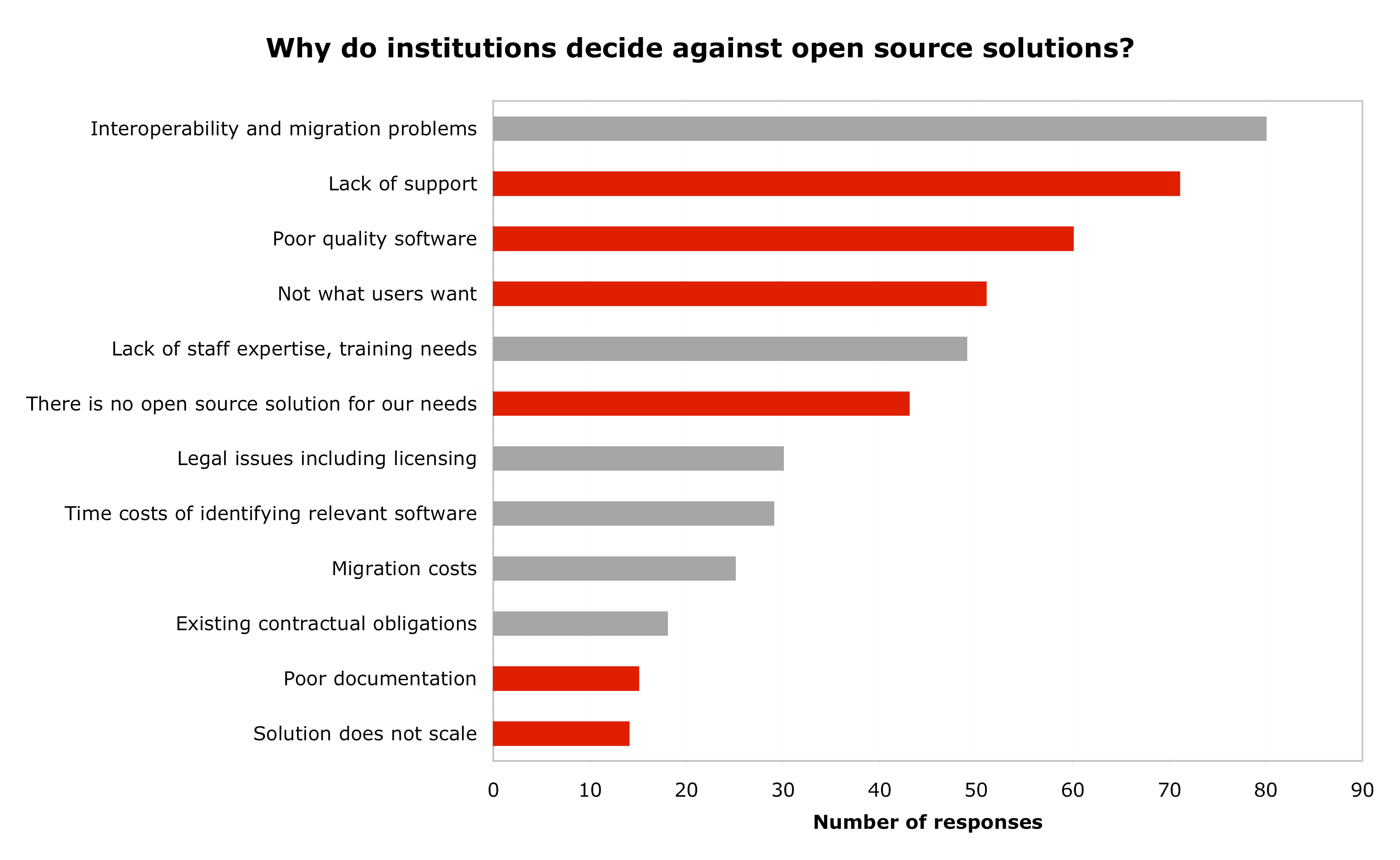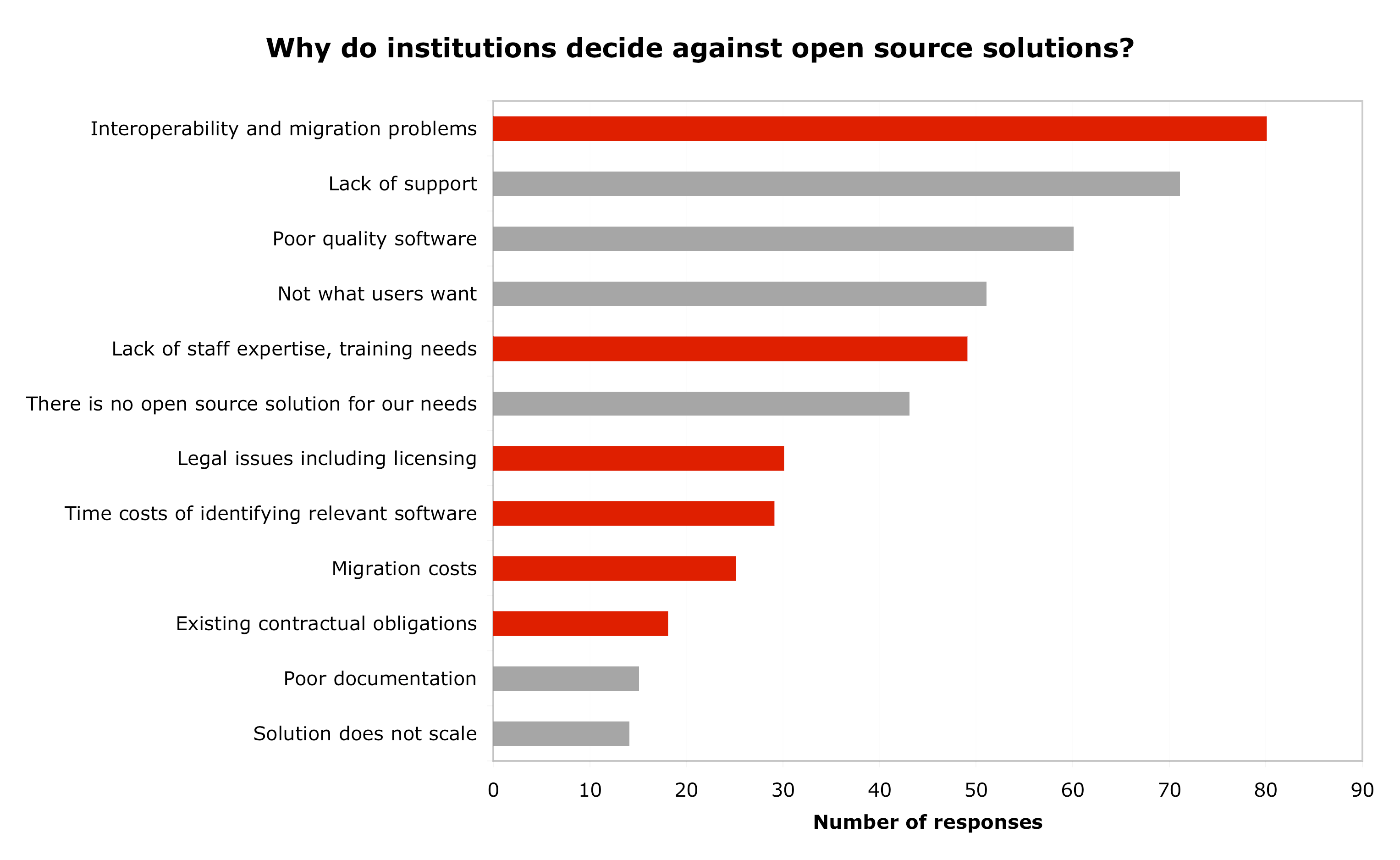In our recent survey on free and open source software in the UK education sectors, we asked colleges and universities for their main reasons for not selecting an open source solution according to 12 criteria. Below you can see how important each of the criteria were rated for software running on servers:
| Interoperability and migration problems | 80 |
|---|---|
| Lack of support | 71 |
| Poor quality software | 60 |
| Not what users want | 51 |
| Lack of staff expertise, training needs | 49 |
| There is no open source solution for our needs | 43 |
| Legal issues including licensing | 30 |
| Time costs of identifying relevant software | 29 |
| Migration costs | 25 |
| Existing contractual obligations | 18 |
| Poor documentation | 15 |
| Solution does not scale | 14 |
The question I'd like to pose today is if we were to consider these as representing the barriers to greater adoption of free and open source software in education, are the barriers to be found within institutions, or are there issues with the available supply of software and services to the sectors?
To answer this I've split the criteria into two groups—supply-side and demand-side. Let's look at the supply-side first of all.
Supply side factors

Three of the top four criteria are supply-side considerations: lack of support, poor quality software, and not offering what users want.
We could also consider "There is no open source solution for our needs" as being largely the same thing as not offering what users want, which would place it as the top concern.
This would imply that, from the perspective of colleges and universities, the open source software community just isn't offering the kind of software products the sectors need.
From our experience in compiling the Open Source Options for Education list, this would seem a bit curious. Perhaps the issue is one of awareness and marketing? Or are there significant niches in education where there really are no open source options? We also know that the procurement processes in many institutions would likely exclude open source from consideration—is this also a factor in this lack of awareness?
The second major issue on the supply side would then be the provision of services and support. As we've seen in the public sector, having commercial partners is a crucial factor in getting solutions adopted. (There is a chicken-and-egg issue here is that there has to be adoption to support a services market, but lack of services hampers adoption.)
Finally there is the quality issue—are open source solutions aimed at education really poor quality? Or is it that the kinds of solutions being considered are not mature?
Now lets look at the demand side.
Demand side factors

The top issue is interoperability and migration problems—if we also add in the respondents who considered migration costs, then it is by far the most cited reason why open source isn't selected.
We've noted before that there is no simple relationship between open source, open standards, and interoperability; while in principle open source affords the adoption of open standards and greater interoperability, the practice is a lot less clear cut.
However, what we haven't untangled here is whether the issue is with open source options lacking interoperability features or standards compliance, or whether the issue lies with the incumbent systems they would replace.
The next ranked issue is lack of staff expertise; again we haven't untangled whether this is a lack of expertise amongst the potential users of the software, the IT operations staff, or the staff involved in the procurement so its hard to interpret precisely. Given the question relates to server software it could be any of these groups.
It may also be the case that this issue goes hand-in-glove with that of lack of support from the supply side; often for server-side software the complexity of configuration and operations can be overcome by contracting a supplier to deal with it on your behalf. For open source options, if there are no suppliers of services available then its up to the institution's staff to figure it out.
Finally, the rest of the issues here fall under the category of contractual, legal and procedural issues with procurement itself. While each individual item is not ranked highly, taken together they suggest there are significant barriers still in place in procurement. This is something we've been looking into recently in more depth, for example in our Decision Factors for Procurement briefing.
Conclusions?
Taken altogether, the demand side and supply side issues of open source adoption in education carry pretty much equal weight from the viewpoint of the institutions themselves. But what are we to make of it?
I think we can distill it into five challenges:
- We need to tackle the interoperability question. Is lock-in a problem? Is lack of standards a problem? This is something our friends at CETIS could take a lead on.
- We need to improve awareness of existing open source solutions available within the sector; lists like our Open Source Options for Education are useful here, but projects also need to be more proactive in raising awareness, and may need a higher profile at events such as the UCISA and ALT conferences.
- Institutions need to improve software procurement processes so that they can consider open source solutions effectively and equally with closed source.
- We need to build up the open source services market for education. ULCC have been very effective with their Moodle hosting, but companies supporting other major open source software solutions don't seem to have much of a presence in the education sector. (As I mentioned earlier though, this is a bit of a chicken-and-egg problem)
- Bootstrap projects in areas where there are no existing open source solutions. Of course there are well known problems with funded projects, but there are alternative approaches, for example the Jisc Co-Design programme could play a role here.
Originally posted on OSS Watch Team Blog. Reposted under Creative Commons.







7 Comments